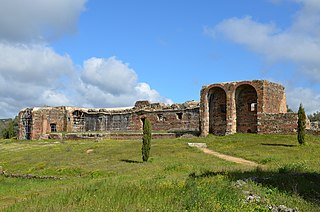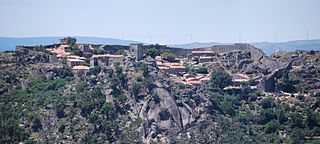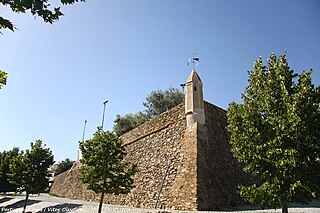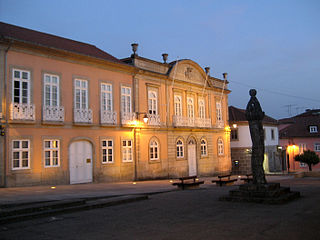
The Ducal Palace of the Braganza or Palace of the Dukes of Braganza is a medieval estate and former residence of the first Dukes of Braganza, located in the historical centre of Guimarães, in the north-western part of Portugal.

The Roman ruins of São Cucufate is a Romanesque archaeological site, located on the ruins of a Roman-era agricultural farm in the civil parish of Vila de Frades, in the municipality of Vidigueira, in the southern Alentejo, Portugal. The convent, which dates back to Middle Ages, was dedicated to the martyred saint Cucuphas.

The Roman Temple of Évora, also referred to as the Templo de Diana is an ancient temple in the Portuguese city of Évora. The temple is part of the historical centre of the city, which was included in the classification by UNESCO as a World Heritage Site. It represents one of the most significant landmarks relating to the Roman and Lusitanian civilizations of Évora and in Portuguese territory.

The Castle of Evoramonte, alternately spelled Évora Monte or Évoramonte, is a Portuguese castle in the civil parish of Evoramonte, municipality of Estremoz in the former district of Évora. Initiated in 1160, in the Gothic period, it was enlarged in later centuries in the Manueline style. It was at this site that the Concession of Evoramonte on was signed on 26 May 1834, that ended Liberal Wars between the Liberal forces of Queen Maria II of Portugal and Absolutist armies of Miguel of Portugal. Since 1910, it has been listed as a Portuguese National monument.

The Tower of Pedro-Sem is a medieval fortification situated in the civil parish of Lordelo do Ouro e Massarelos, that protected the northern Portuguese city of Porto.

The Castle of Alcácer do Sal is a medieval castle located in the civil parish of Alcácer do Sal e Santa Susana, in the municipality of Alcácer do Sal, Portuguese district of Setúbal.

The Castle of Sortelha (Portuguese: Castelo de Sortelha is a castle in the civil parish of Sortelha in the municipality of Sabugal in the Portuguese Centro region, classified as a National Monument.

The Castle of Alcanede, is a Portuguese medieval castle in civil parish of Alcanede, in the municipality of Santarém, in the Ribatejo district of Santarém.

The Castle of Alenquer, is a Portuguese medieval castle in civil parish of Alenquer, in the municipality of Alenquer, in the district of Lisbon.

The Castle of Arronches, is a Portuguese medieval castle in civil parish of Assunção, in the municipality of Arronches, in the district of Portalegre.
The Castle of Atouguia da Baleia is a medieval castle in the civil parish of Atouguia da Baleia, municipality of Peniche, and in the Oeste region of the historical Estremadura province.

The Curutelo Castle is a well-preserved medieval castle located in the civil parish of Ardegão, Freixo e Mato, in the municipality of Ponte de Lima, Portuguese Viana do Castelo.

The Castle of Folgosinho, is a medieval castle in the civil parish of Folgosinho, municipality of the Gouveia in the district of Guarda in the Centre region of Portugal.

The Pillory of Arcos de Valdevez is a 15th-century sculpted stone column with symbolic political, administrative and judicial significance, located in the civil parish of Arcos de Valdevez (Salvador), Vila Fonche e Parada, municipality of Arcos de Valdevez.

The Chapel of D. Fradique is a chapel located in the Convent of São Francisco, in the civil parish of Estremoz, in the municipality of Estremoz, in the Portuguese district of Évora.

The Castle of Penedono is a medieval castle located in the civil parish of Penedono e Granja, in the municipality of Penedono, Portuguese district of Viseu.

The Castle of Santo Estêvão is a medieval castle located in the civil parish of Santo Estêvão, municipality of Chaves, in the Portuguese district of Vila Real. Located in a dominant position over the village, the castle is within walking distance of the course of the river Tamega and the border with Spain.

The Castle of Castelo Melhor is a medieval castle located in the civil parish of Castelo Melhor, in the municipality of Vila Nova de Foz Côa, Portuguese Guarda. The castle is one of the best examples of secondary medieval fortresses, erected in one of the more peripheral zones of the peninsular kingdoms.

The Castle of Castelo Bom, is a medieval castle in the civil parish of Castelo Bom, municipality of the Almeida in the district of Guarda in the Centre region of Portugal.

The Castle of Bemposta is a medieval castle in the civil parish of Bemposta, municipality of Mogadouro, in the Portuguese district of Bragança.






















